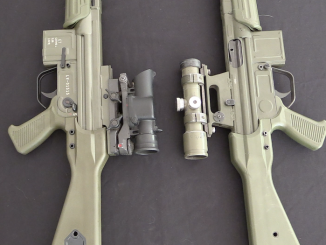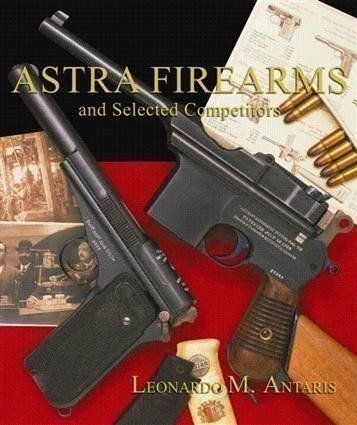Today’s high speed video analysis is the first Browning-style pistol that was at hand when I took out the camera: a Star Model B Super. Manufactured in Spain for many years, this basic pistol was made in both 9mm Luger and 9mm Largo variations as well as full-size and shortened varieties. This particular one is in 9mm Largo, and is a fine example of the tilting-barrel action developed by John Browning that dominates handgun design to this day.
Watch all the way to the end for bonus footage of a hangfire in slow motion!




The differences between a Star Model B and ANY 1911: No grip safety, no mainspring housing (machined in the frame), trigger has a pivot pin and disconnector is in a dove-tail in the frame. Firing pin is retained by a pin under the rear sight, no grip bushings, I might be forgetting an thing or two…
It also has a linkless barrel, and there is a disassembly lever above the trigger on the right side of the frame.
Here is the US patent for the linkless barrel design and disassembly latch.
https://www.google.com/patents/US2664786
With patent applied for in 1947, where would be improvement to already existing GP35? You still need to pull out the lever to disassemble.
No, you just have to rotate the latch so it will clear the rear lug of the barrel.
I see, there is cutout. One less part to loose. Thanks.
Star also has an outside extractor. This kind of case drawers are advantageous when a
live round sticked within the chamber. It is also interesting that, diassembly latch construction was dublicated by Glock in his pistol patent.
You find similar takedown latches on the Berettas (Model 1951 and later, including the M92),the Desert Eagle, and a few others.
cheers
eon
What dublicated is not the existing take down latch of production Glocks. The dublication takes place in the Glock patents before the current form revealed and being nearly same as Star’s. Kindly looking releated patents
would give enough idea.
Hey Ian! I happened to notice that there was a machined groove on top of the slide behind the ejection port. What purpose does this serve?
It has a loaded-chamber indicator behind the ejection port.
Thank you for the answer.
I once owned a Super A in 9x23mm and was amazed at what an advanced design it was for its era. Linkless “ramp” unlocking system, loaded-chamber indicator, full “figure 8” barrel bushing like a Tokarev, Beretta-type disconnector under the right grip panel, external “bar”-type extractor, and one-touch takedown with the flip lever above the trigger guard on the right aside.
I once calculated that if you ordered a custom 1911 with all of the above features, it would set you back about $1400 over and above the cost of the pistol for the custom smith to work on.
Not bad for a pistol I paid $189 for at my local stocking dealer.
BTW, CCI used to make Blazer 124-grain JHP in 9x23mm, which had roughly the ballistics of the .38 Super Auto JHP load and makes the Largo-chambered version a pretty serious defensive pistol.
cheers
eon
That make me wonder if there was commercial potential in the US market a reproduction of Star P (in .45 ACP) …? Or is it perhaps too different from a standard 1911? From what I have gathered is that the Star P was a very well liked pistol, but the Star company (when it still existed) was quite poor at marketing their products abroad.
A modern P Super clone would need to have a certain level of M1911 interchangeability in order to thrive in the US market. At minimum, it would need to use M1911 magazines.
One could argue that the Colt Mustang and its relatives like the SIG-Sauer P238 and P938 are little more than value-engineered Star variants. Perhaps instead of a full-size Model P or compact PD, someone might have better luck designing a purpose-built variant of Tim LaFrance’s sub-compact Six-Pack conversion.
The magazines on the Llama autos in .45 and .38 Super were interchangeable with Colt magazines, but nothing on the Stars interchanged with anything.
Yes, I do believe this was a major “marketing” error on Star’s part.
cheers
eon
They were made in metric system. Would you call it error? I’d think it is default.
Can you do a slow motion shot of a Steyr 1912 Pistole?
Thanks for posting this!
El Gato
Yep, the 1912 is on my list to do in slow motion.
Considering some Star models are selective fire, we can speculate on which is the most controllable, with or without wooden butt, etc…
An overlooked aspect of these Star pistols is that are often used by movie armorers as substitutes for the 1911 (Samuel L. Jackson’s 1911 in “Pulp Fiction” and Richard Crenna’s 1911 in “The Sand Pebbles” are two that I can think of offhand). According to someone I know in the industry, the design functions much better with blank ammunition than does the 1911, probably due to the linkless barrel and external extractor. That feature is often the “giveaway” if one looks closely at the “1911” being used in the film.
All the “Colt .45s” used in the TV series Voyage to the Bottom of the Sea( 1964-68) were Star or Llama 9mms. The external bar extractor on both gives them away every time.
According to David Hedison (Capt. Lee Crane), whom I met a couple of times at SF cons in the Seventies, they used them because the Colt 1911 .45 just wouldn’t work with the blanks they had back then.
Today, of course, they use Colts and other guns that have been massively re-engineered for film work (straight-blowback actions with bore restrictors, etc.), but back then, the budget for an entire episode of an hour-long SF/spy drama like VTTBOTS was about what most TV production companies spend on lunch every working day. There wasn’t time or money for that sort of thing.
SMGs like the Beretta M38 were the easiest to get working, he said, being straight blowbacks; a bore restrictor would do it. The hardest thing to get to work was the Parabellum (Luger); you had to drill and tap a hole in the toggle for a stud to raise the knee-joint just enough that it acted like the later Erma blowback .22 version. If the stud was too “high”, the toggle opened while there was still too much pressure in the barrel, with predictable (and dangerous) results.
Stembridge Gun Rentals did about all their “gun work”, just as they dd for most TV and movie productions. They had a man on set who acted as the “unit armorer”, taking care of all the guns, loading and servicing them, etc.
Oddly, they rarely got visited by the Alcohol, Tobacco, and Firearms Bureau of Treasury. Which seems weird, as they had a man on set over at Wanted- Dead or Alive all day, every day, riding herd on Steve McQueen’s cutdown Winchester, the “Mare’s Leg”.
Go figure.
cheers
eon
I have been to Stembridge’s many years ago, when they were still in business, with the previously mentioned individual. Sid Stembridge had a 20mm Vulcan cannon from “Blue Thunder” sitting in his office, and rooms full of MP 40s, STENs, and other Class 3 goodies, as well as countless examples of old western firearms from the glory days of Hollywood westerns, including enough trapdoor Springfields to equip an army. It was an amazing collection, and I always wondered if they would have needed a resident ATF agent to keep track of all the full auto stuff, most of which could easily be restored to firing condition. Indeed, a lot of the static props were unconverted. I remember walking out of the main warehouse with my friend, shaking from the excitement. He asked, “Well, what did you think?” I replied, “I wish the boss would adopt me!”
One of my biggest gun regrets was trading away an immaculate parkerized Star 9mm military issue (exact model and designation long forgotten) with wood checkered grips that was just BEAUTIFUL, and a shockingly accurate shooter. I remember nailing a milk jug repeatedly at 100 yards offhand with the fixed sights. Why I ever let it go is a mystery to me today…probably because it wasnt a magnum or because the caliber didn’t begin with a “4”… I’m an idiot sometimes.(sigh)
The Star Model B I had was not a “Super”, and had a link just like a 1911. I acquired it with a broken firing pin, contacted the company, that went nowhere, and made one myself. Great product from Eibar Espana; just not customer service by how the rest of the world operates!
I had a Super in 9mm Largo back in the 1980s. Back then Largo was basically unobtainium, so I turned the rims off .38 Special brass, cut an extractor groove, and cut them down to Largo length.
BGs kicked their way through the back door and “liberated” it along with various other items, but I’ve always remembered that gun fondly.
The size difference from a 1911 isn’t much, but the Star sure *feels* smaller…
I used to own a selective fire version of the Star about 50 years ago
One thing about my Star 9mm BM was there was the potential to “Superman” it after firing the 8 shots. You could throw it at your intended target and possibly seriously hurt them because it weighs so much. The Superman of course refers to the bad guys shoting George Reeves as Superman 6 times with a revolver which always bounced off him so they would throw the gun and hit him in the chest. He would catch the gun rebounding and twist it into a pretzel from the 1950s Adventures of Superman